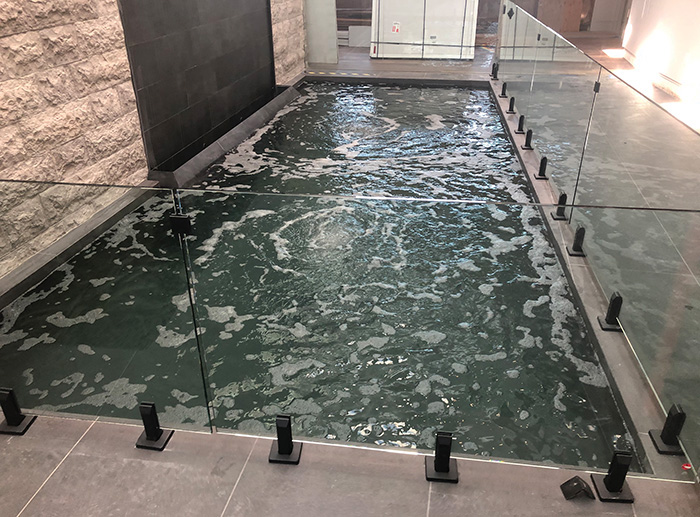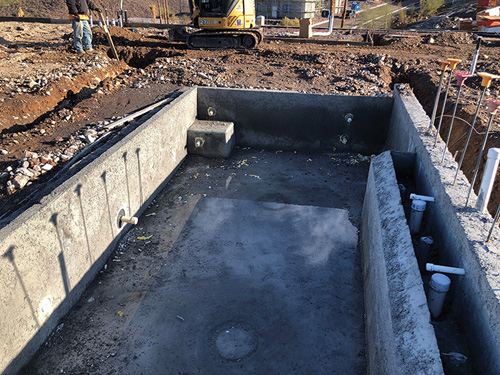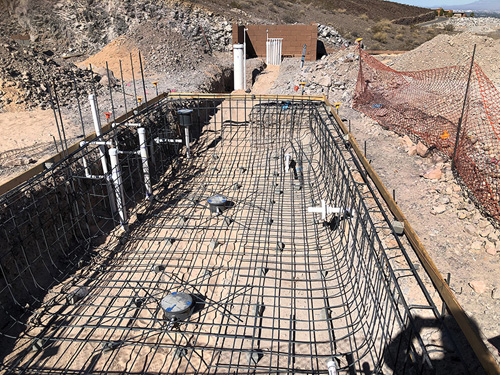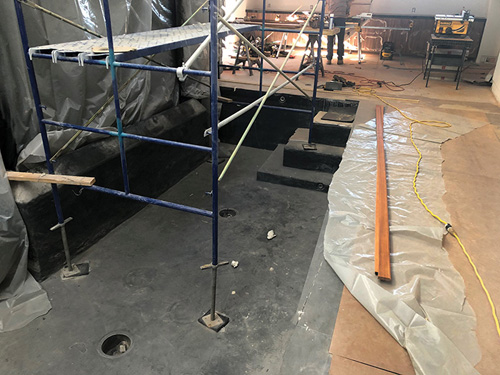
When the new owner of a yet-to-be-built home wants a koi pond and the house gets built around it, the pond shell is often the first concrete to be installed.
This project started in late 2019 and finished in the spring of 2021. The pond is a trapezoid-shaped interior koi pond inside the home’s entrance from the garage area on one side and the front entry of the home on the other end. Entering the home, you pass by the koi pond first. A ceiling-high water wall is the backdrop for the pond. A year earlier, the owner had a similar design for a home through another developer that did not get built. The design for the water wall over the pond was a theme that was important to the owner. When the owner changed developers and moved over to Blue Heron, he took the water wall concept and me with him. Water walls can be a maintenance issue over time, so the decision was made to make it a separate system from the pond, isolating it with a narrow trough just above water level as a chlorinated feature.
The water wall, koi pond shell and the outdoor swimming pool were all constructed by Anthony and Sylvan Pools in Las Vegas, Nevada. Anthony and Sylvan Pools has always been cooperative when following my pond-plumbing requirements, such as no hard 90-degree bends and the use of drain waste and vent fittings throughout. They stubbed out the plumbing in the filter pit area as a combined manifold and left it with all the plumbing lines in and out of the pond, including the air lines, staying pressurized throughout the project. The inlets and outlets on the drains are internally threaded for pressure testing, as are the 1 ½-inch return fittings and skimmer. Paul Parszik of Artisan Aquatics came in to apply the polyurea seal coating and really enjoyed working indoors and out of the weather for a change.Filtration Design
At just over 4,000 gallons, this formal design was perfect for vertical pond return drains operated with an air lift system. At 20 feet long by 8 feet at one end and 10 feet wide at the other, I used two vertical pond return (VPR) drains, one in-pond floating weir skimmer mounted in the top step and one midwater drain on the long side opposite the water wall. The returns are the 3-inch center up-flow lines in the VPR drains and six 1 ½-inch returns with four of them on the short wall opposite the wall where the skimmer is located.
>> Pond Construction | Best Practices Archive
Each drain has a 3-inch line traveling directly to its own 55-gallon drum radial separator as prefiltration. As each line comes up toward the inlet to its tank, a 3-inch DWV sweep tee is used as the turn into the tank, with the open end extending just above tank level as a vented cleanout for future use. The two tanks are connected at the bottom with a 3-inch knife valve separating them during normal operation. During cleaning, the valve is opened so the discharge pump in one of the tanks can drain both at the same time, eliminating the need for two pumps.

A 3-inch line connects each prefilter to another 55-gallon drum containing an aerated biofilter with a 4-inch air lift in the center. Two 3-inch transfer lines in equals one 4-inch line out. The 4-inch line out is connected to a 4-inch down-flow air purge line divided into two 3-inch returns to the centers of each VPR drain. The down-flow air purge line is set at a slight angle to help air find the high side of the pipe and travel back up to the top without fighting the downward flow of water.
Circulation & Plumbing
This system has three air pumps. One 80 LPM Medo air pump on a timer supplies air to the two air rings on top of the VPR drain domes through a pair of small valves for balance. The second is a 45 LPM Medo air pump supplying air to the 4-inch air lift, creating between 4,000 and 5,000 gph of water flow through the system. The third is a 60 LPM Medo air pump supplying the air ring inside the aerated biofilter. The air ring is located near the outer edge of the filter, creating a circulation pattern within the tank up the outside and down the center, allowing the bacteria housed on the media to encounter the ammonia-rich water multiple times for each pass through of water in a similar fashion — as a moving bed, but without moving the media. The media is 7 cubic feet of Matala chunks. I prefer using Matala as 2-inch chunks rather than flat sheets, because I think it allows for better flow along with easier cleaning with an air blower.

The skimmer and midwater drain each have 2-inch dedicated lines valved together at a manifold just before the inlet to an external pond pump. The pump is a WLim Wave 1 1/6 Horsepower pump flowing approximately 4,000 gph pushing water through a low-pressure biofilter and back to the pond through the six 1 ½-inch returns. The pressurized biofilter is one of my own designs, creating almost no pressure as a fines filter. This design allows the use of the most efficient low-pressure pumps on the market. The UV light is a 4-inch diameter, 57-watt flow-free design installed between the external pump and the low-pressure biofilter. Clarity Pool Service in Las Vegas did an amazing job with the filter installation and connections to the plumbing.
Solar Protection

Toward the end of the project, the owner asked me if there were covers for the tops of the 55-gallon drum filters. I had stopped trying to supply covers for these some time ago, because everything I have constructed them out of gets destroyed by the Las Vegas sun. He really wanted something, so I created shade cloth covers with a bungee cord-style nylon ring to hold them in place. The shade cloth should last for quite a while, considering it is made to be in the sun. So, here’s hoping for the best!
With the pond running and the bottom drain air diffusers switched off, the surface looks completely still. This is a great effect, considering the pond is just over 4,000 gallons with a total flow rate of at least 8,000 gph, all fully oxygenated in real time using air-lift technology.


